by Lisa Cooke | Apr 29, 2019 | 01 What's New, Writing Family History |
Standing in judgement of our ancestors may be unavoidable. Genealogists dig up the good, the bad, and the ugly. We cannot pick and choose what we find, but we might be able to pick what and how we share it with others.

Recently, I received a letter from a Gem’s reader which included a very delicate and sensitive matter. She writes:
Hi Lisa!
I love your blog and podcast. Thank you for all you do getting gems together for us! I have a question for you and would love to know your opinion (or the opinion of anyone else as well!)
I was recently at a family wedding. I printed out all the family and ancestor’s paper trails and documents and was passing them around to my aunt, uncles, and cousins. My mom’s eldest brother brought up a memory he had of his grandfather, my great-grandfather, a German immigrant. My uncle whispered it to me because the saying my great-grandfather often said is very prejudice. I won’t tell you what the quote is but it’s prejudice against Jewish, Irish, and Dutch people. Here’s my question – should I write down that my great-grandfather was prejudice against certain people to preserve this part of his character or should I let this information fade into history? As genealogists we are always trying to get a full view of the person we are researching – past the census records, military service paperwork, and wills – and into the real person and personality. So, I now have a more broad view of my great-grandfather, but it’s negative. Should I preserve this character flaw in my ancestry notes? I’m conflicted about what to do. Maybe if this was a further distanced relative I would have an easier time brushing aside this prejudice but I’m having a hard time with the “right thing to do.” Any advice would be wonderful!
As a side note I will tell you that in the following generations this mans’ children and grandchildren have married Irish and Jewish spouses. Haha. I guess the “saying” was never echoed by his descendants!
Thanks,
Jennifer
Judgement of Our Ancestors
This is a great question and I applaud you for thoughtfully taking a moment to really think it through and ask for advice before moving forward on recording what you were told.
You asked – Should I write down that my great-grandfather was prejudice against certain people to preserve this part of his character or should I let this information fade into history? My opinion is, no. Mother Lisa says this is gossip and you didn’t hear it straight from your great-grandfather. I certainly wouldn’t want anyone else attributing a negative comment to me without having the chance to review or rebuke it. It’s a slippery slope.

Little Tea & Gossip by Robert Payton Reid, Source: http:⁄⁄www.liveinternet.ru⁄users⁄pmos_nmos⁄post357791815⁄
You also asked – Should I preserve this character flaw in my ancestry notes? And there’s the slippery slope. I believe that we, in modern times, should avoid sitting in judgement of ancestors who are not here to defend themselves. We don’t want to presume that we are in a position to decide how wrong “the crime” is. We certainly don’t want to be negatively prejudiced against others ourselves, but it is impossible to put oneself in another’s shoes in a differing time and circumstance. We know nothing about what the person really said. Perhaps they were joking (even though in extremely bad taste!) Maybe the person who heard this, and passed it on, had an ax to grind and part or none of it is true. Or, maybe there was an experience that our ancestor suffered that could have given him a reason to gripe based on his personal experience. You just don’t know.
In my book, I would chalk this up to gossip and either prove it with substantiated evidence or move on. What goes around comes around so let’s hope it will prevent an occurrence of someone gossiping about you and your future descendant spreading it into the ages.
Deciding to Write the Whole Story
In cases where you have secured substantial evidence that a negative story is true, you still have a choice to make. When I come across particularly sensitive or negative information about an ancestor, and before I make it public, I ask myself, “who will this help, and who will it hurt?” Does adding it to the family history enrich it? Is there anyone living today who might be hurt? If someone stands to be injured, but you’re set on capturing the story, I encourage you to do so privately for your own records and of course, cite all of your sources.
If you do decide to write and publish sensitive stories, I know that you will want to do so in as gentle and fair a way as possible. Here are some things to consider when writing about delicate stories of our ancestors:
- Be sure to cite your source – who told you the story and when. The reader can decide whether to take the story with a grain of salt or believe it.
- Let your readers know your reason for sharing the story in the first place. Genealogy Gems blogger Amie Tennant recently read a family history that included a horrible childhood memory. The writer stated it was important to put the family dynamics in full view so that other stories would be seen in the “right light.”
- If naming everyone in the story will cause hurt or embarrassment, consider documenting the essence of the story without naming names.
Whatever you decide, writing a family history, though difficult at times, can be a rewarding experience.
by Lisa Cooke | Oct 26, 2016 | 01 What's New, Amish & Mennonite |
Anabaptist genealogy records include Amish, German Baptist and Mennonite ancestors. In a past post titled “Amish Genealogy Revealed,” we shared tips for searching out your Amish family tree. Here are more helpful resources submitted by our wonderful readers that you won’t want to miss.
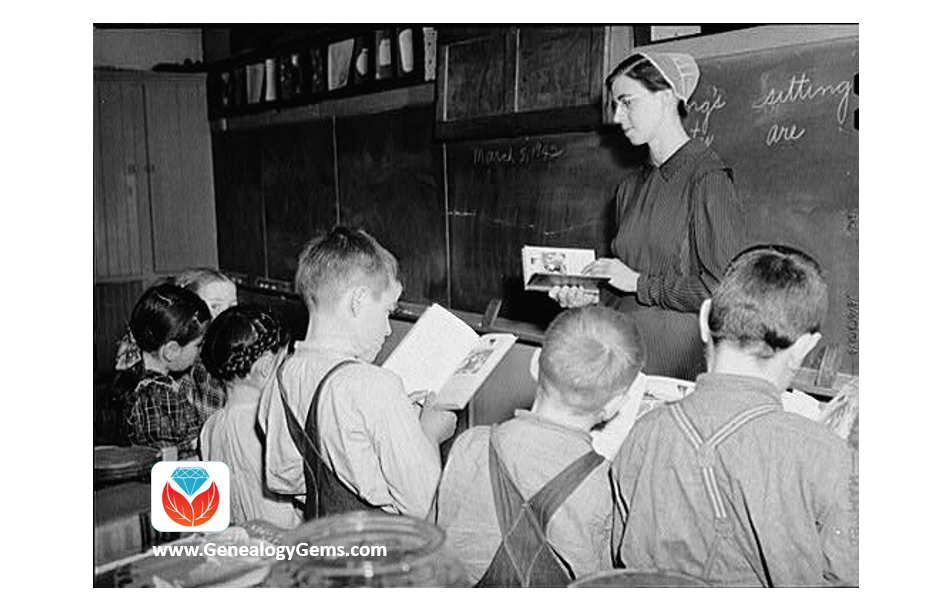
What is an Anabaptist?
The term Anabaptist refers to those religions who reject infant baptism in favor of a believer’s baptism. Amish, Mennonite, and German Baptists fall into the category of Anabaptists.
Anabaptist religions often subscribe to more conservative views and dress. Their families are very much intertwined with their religion, making the study of their history rich in detail and customs.
Anabaptist Genealogy Records: More Amish and Mennonite Family History Resources
We shared in our “Amish Genealogy Revealed,” the resources of the Amish newspaper, The Budget, the Amish church directories, and newsletters and books on Amish families. Many thanks to reader Loren Johns for sharing yet another amazing resource. Loren shared:
As someone who has a couple of hundred thousand Amish in my genealogical database, I enjoyed reading your focus on Amish genealogy. Somewhat surprised to see it!
You did not mention the
most important source for Amish genealogy. It is the
Swiss Anabaptist Genealogical Association, of which I am the secretary. This is a rather informal non-profit association of amateur genealogists interested in Amish and Mennonite genealogy who share their research with each other and with others interested in it, and make it available online.
Further, Mr. Johns shares that the Swiss Anabaptist Genealogical Association (SAGA) maintains a large database of un-merged databases that can be searched simultaneously. He gives an example:
If I search for an Amos J. Whetstone (an Amish name,) I get 17 hits, to three separate men. Amos J. Whetstone (1903-1984) appears in 6 different databases; Amos J. Whetstone (1919-2003) appears in 4 databases; and Amos J. Whetstone (1945- ) appears in 7 databases … so the 17 hits actually represent three men.
This amazing SAGA database contains over 5,000,000 names, though many of those are duplicates. You can imagine the value of such a large database for this specific group. If you are interested in joining SAGA and gaining access to the database, see the membership page
here.
Lastly, Mr. Johns leaves us with this fine tip!
A most important book on Amish genealogy is Amish and Amish Mennonite Genealogies by Hugh Gingerich and Rachel Kreider. It is sometimes called the Amish genealogy “Bible.” It traces all of the Amish immigrant ancestors (144 different surnames) and their families to 1850, where it had to stop lest it explode into an encyclopedia.
Anabaptist Genealogy Records: Resources for the German Baptist or The Old German Baptist Brethren
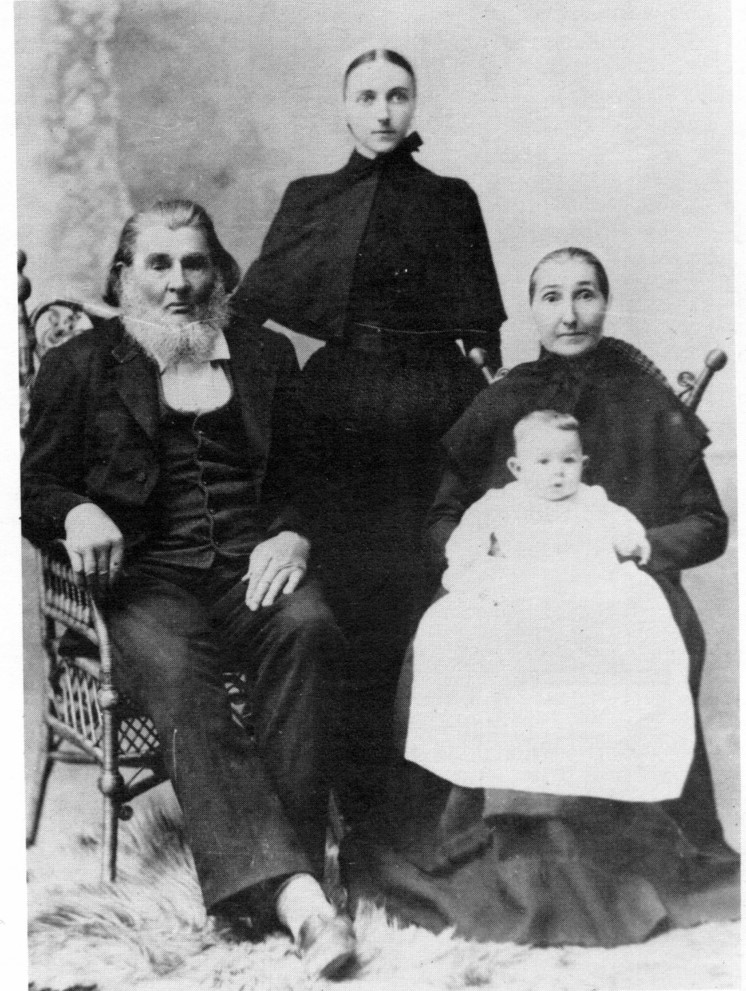
George Funderburg and family were members of the German Baptist faith.
Another group of Anabaptist’s are the German Baptist, also known as the Old German Baptist Brethren. Here in Ohio, we sometimes refer a particular break-off by their nickname, Dunkards. The Dunkards were given this nickname for their belief in baptism by immersion.
It is my own family ancestors who were among the Dunkards. Luckily, we have a wonderful archive in Brookville, Ohio called Brethren Heritage Center. The Brethren bodies involved with the Brethren Heritage Center are:
- Church of the Brethren
- Conservative Grace Brethren International
- Dunkard Brethren
- Fellowship of Grace Brethren Churches
- German Baptist Brethren
- Old Brethren
- Old Brethren German Baptist
- Old German Baptist Brethren
- Old German Baptist Brethren-New Conference
- Old Order German Baptist
- The Brethren Church
This heritage center offers many books and collections including family histories, maps, letters, diaries, census records, and birth records. In particular, the heritage center website also has a large list of helpful links to begin researching your Brethren ancestors. To see the list of links, click here.
Anabaptist Genealogy Records – Share Your Knowledge
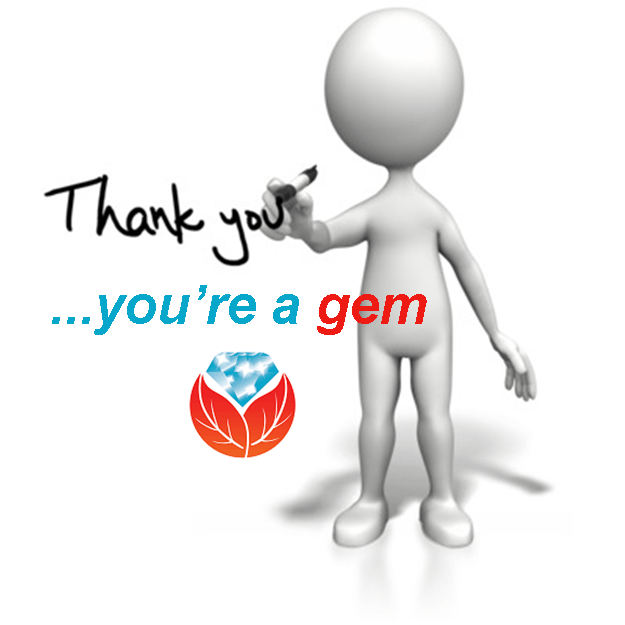 If you have Anabaptist heritage, you may be aware of additional Anabaptist genealogy records that we have not mentioned. We would be delighted if you would share that information with our Genealogy Gems community in the comments below. We look to you to be an inspiration and teacher to us here at The Genealogy Gems Podcast, and you always come through. Thank you!
If you have Anabaptist heritage, you may be aware of additional Anabaptist genealogy records that we have not mentioned. We would be delighted if you would share that information with our Genealogy Gems community in the comments below. We look to you to be an inspiration and teacher to us here at The Genealogy Gems Podcast, and you always come through. Thank you!
by Lisa Cooke | Nov 28, 2016 | 01 What's New, Video
It’s a common phenomenon for the genealogist: the eye roll!
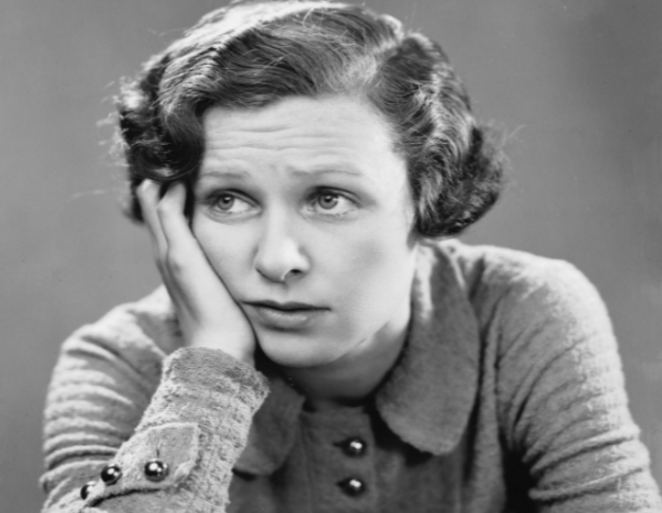 Relatives who have never had a desire to delve into genealogy often roll their eyes when an enthusiastic genealogist in the family shares a newly discovered census or other genealogical record. And who can blame either party? The genealogist is giddy having won a long fought battle to unearth another piece of the family tree puzzle, and the non-genealogist hasn’t a clue what difference it all makes.
Relatives who have never had a desire to delve into genealogy often roll their eyes when an enthusiastic genealogist in the family shares a newly discovered census or other genealogical record. And who can blame either party? The genealogist is giddy having won a long fought battle to unearth another piece of the family tree puzzle, and the non-genealogist hasn’t a clue what difference it all makes.
Creating a short story slideshow video about your family history is an ideal way to bridge that gap. Here at Genealogy Gems (on my blog, podcast, and YouTube channel) I’ve shared not only examples of professional-quality videos, but also the step-by-step instructions for creating them with one of my favorite website tools called Animoto. It’s an online video creation tool that requires no special skills or software. You just drag and drop your content (digital images and even video files) and select from Animoto’s cache of professional video styles and music tracks. Within minutes you can whip together a video that generates not eye rolls, but instead, ooos and ahhhs!
(Full disclosure: This post contains affiliate links and I will be compensated if you make a purchase after clicking on my links. Thank you for supporting the Genealogy Gems blog!)
Simple slideshow videos aren’t the only eye-rolling defense weapon in Animoto’s arsenal. You can take your video creation to the next level with Animoto’s Marketing Video Builder . Don’t let the name fool you, because it’s rich with features that any genealogist can sink their teeth into.
. Don’t let the name fool you, because it’s rich with features that any genealogist can sink their teeth into.
One of the key features you get with the Marketing Video Builder, available with Professional and Business subscriptions, is the ability to add voice narration to your video. Your voice (or the voice of relatives that you interview) will bring an intimacy and personalization to your video project that will tug on your viewer’s heart strings.
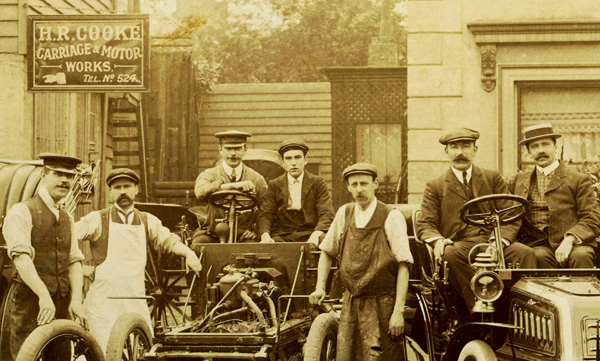
Raymond age 13 (4th from left) and his father Harry Cooke (2nd from right), Tunbridge Wells, England circa 1909
Recently I took the Marketing Video Builder for a whirl on a project that I’ve been wanting to do for a long time: the story of my husband’s great grandfather. My husband’s grandfather, Raymond Cooke, wrote up a short autobiography just before his death in 1987. It’s a wonderful glimpse into the world of his youth and his memories of his father, Harry Cooke.
I used the portion of the autobiography that was focused on Raymond’s father Harry to create an outline for my video. I then set up a project folder on my hard drive, selected images that represented the story, and copied them into the folder. In the image below you can see how I laid out my plan in a simple Word document. This created a script that indicated which portion of the autobiography would be read for each image.
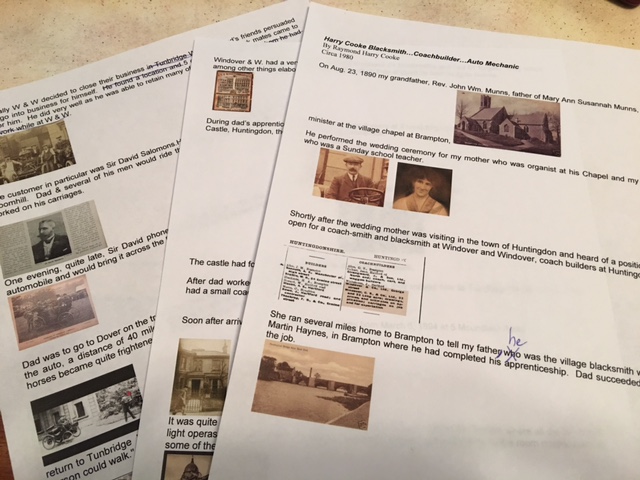
The video script indicates the image and the narration that accompanies it.
The next step was to head to Animoto.com, sign in to my account, click the “Create” button and select “Marketing Video.”. I selected a pre-built storyboard called Portfolio because I really liked the design, but changed the music to a lilting melody called A Thousand Years that I found in the vast music collection. It had just the right for the feel of the story!
The beauty of a marketing video is that you can personalize the storyboard with your choice of font and colors, and you can add and delete sections as you see fit. Animoto always gives you the ability to customize your storyboard so that it fits your imagery perfectly.
With my storyboard set up, I proceeded to upload all the content I had gathered in my project folder. It’s super simple to drag and drop them into the right order.
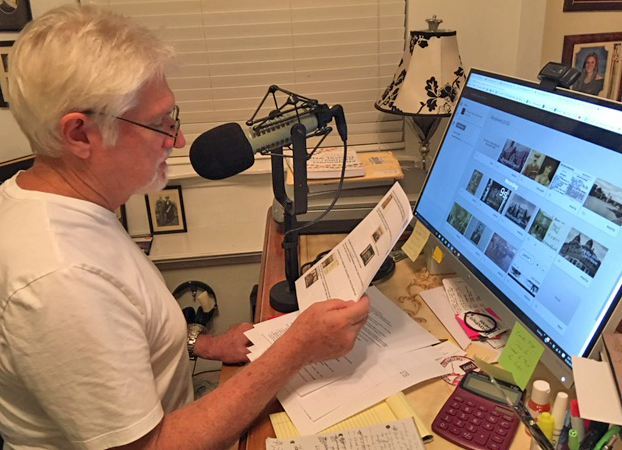
Bill recording his Grandfather’s words for the video
Next, I recruited Raymond’s grandson, my husband Bill, to narrate the video, using Animoto’s voice-over feature. He was a little hesitant at first, but once he saw my outline and script, his enthusiasm for the project grew and he agreed.
I kept the dialogue brief for each image, because the length of the narration dictates how long the image appears on the screen. I found that 2-3 sentences per image was plenty, and the recordings averaged about 14 seconds each. You will be able to see in the bottom left corner of the tile how many seconds you recorded. And rest assured, you can record as many takes as you like and play them back to ensure you love the final result!
The Preview button is your friend, and I encourage you to preview your project several times throughout the creation process. When you are happy with the final video, click the Produce button that appears in the Preview window. This part of the process is just like Animoto’s Slideshow Video Builder. Click here to read my blog post and watch my step-by-step tutorial video.
With a bit of planning out your story, collecting your content, and production time on the Animoto website, you can get results like this:
I love that Raymond’s grandsons voice shares his words with the viewer!
Videos like these are so simple to create, and will bring your family history to life in a way that every member of your family will enjoy. And the holidays are just around the corner. Why not share your family history video when your family gathers togethers? Then, get ready for the ooos and ahhhs!
by Lisa Cooke | Apr 5, 2017 | 01 What's New, DNA
Trying to contact your DNA matches can be frustrating when they don’t respond, but it’s still worth reaching out to them. This researcher’s example shows a good reason why.
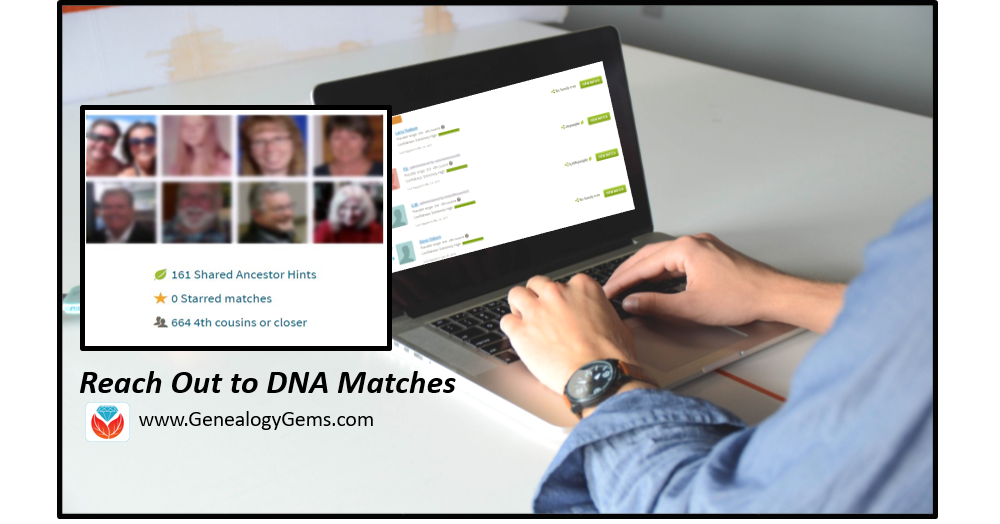
Contact Your DNA Matches
Recently, I heard from Genealogy Gems Premium website member Ruth*, whose DNA success story reminds me of the value of reaching out to DNA matches, even if the general response rate is low or slow. She says:
“I’ve been researching my family tree for over 20 years and sometimes it can get boring…because most of the lines are pretty much out as far as I can go and I’m now just working on brick walls! I love listening to your podcast because it motivates me to keep going!
Like many of your listeners, I have taken the autosomal DNA test. It has been an awesome tool helping me confirm family lines and sometimes finding new ones. However, I’m sure most of your readers know that for some reason a lot of those DNA matches and even tree owners in general, do not respond to emails or messages. It can be very frustrating, especially if it is one of those lines that you really could use some help on. The lack of response to inquiries sometimes makes me wonder if I should even try to make contact. Well, I want to tell your listeners, that yes it is worth it.
Recently, I was browsing trees and I came to a tree that listed my 3rd great-grandfather Daniel Cannon; however, this tree listed Daniel’s wife as Mary Ann Watkins and I had her as Mary Ann Cook! Well, I decided to contact the owner of that tree and explained I had Daniel’s wife as a Cook. The two of us started emailing back and forth and I found out this gentleman, whose last name is Watkins, had taken a DNA test and was in Ancestry.com’s database.
Sure enough, when I searched my mom’s matches I found him. Mr. Watkins shared the information he had [which was] an excerpt that listed the heirs of G. B. Watkins and Elizabeth Smith. On that list was Mary Ann Constable. From the census records, I knew that Mary Ann Cannon had married Thomas Constable after her husband had died. The marriage license for Mary Ann Cannon and Thomas Constable is no longer at the courthouse, but I was able to get a copy of the excerpt of the book it was recorded in. So now I’m climbing a whole different tree!
So, go ahead and reach out to those matches or those people who have trees with different information from you. You never know when you’ll find information and end up with a new line to research!”
Time to Maximize Your DNA Matches
 Our resident genetic genealogist, Your DNA Guide Diahan Southard, has written a series of 3 DNA quick guides to help you maximize your DNA testing experience:
Our resident genetic genealogist, Your DNA Guide Diahan Southard, has written a series of 3 DNA quick guides to help you maximize your DNA testing experience:
This “value pack” can help you sort your matches more wisely, reach out to them in a positive way, and track your correspondence. Click here to read more about these guides and order your own. (Also available as digital downloads.)
Time to Test Your DNA Today
These companies all provide autosomal DNA testing, the most popular kind of DNA testing, and the kind Ruth used. Autosomal testing matches you to genetic relatives on both sides of your family tree to a depth of about 4-6 generations. Learn a little about each by clicking on the names below.
Ancestry DNA
MyHeritage DNA
23andMe
FamilyTreeDNA
*Ruth’s letter was erroneously attributed to Liz when it was shared and discussed in Genealogy Gems Podcast episode 200. Sorry for the mix-up!
by Lisa Cooke | Aug 5, 2017 | 01 What's New, Conferences, Family Tree Magazine
I’m excited to keynote Family Tree University’s Fall Virtual Genealogy Conference, September 15-17, 2017. Get three days of video presentations packed with DNA research strategies, the latest tech tools, organization and preservation tips, and MORE! Sign up by September 15, 2017 with our coupon code for off registration.
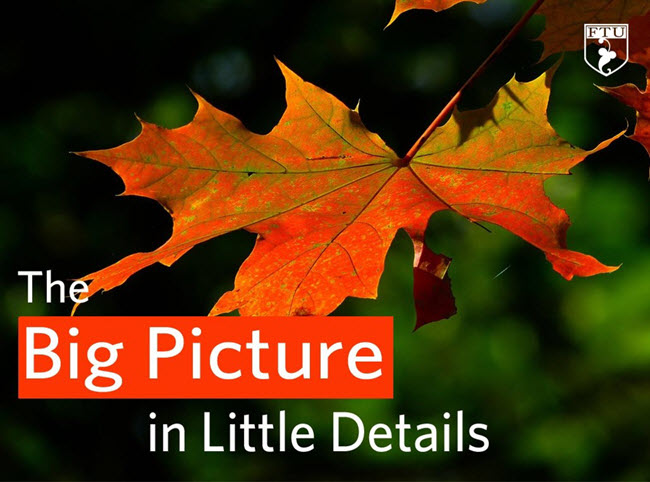
My grandmother was fond of saying, “The devil’s in the details.” I’m not sure about the devil’s current residence, but I do know that even the smallest details can add up to a really big picture. As genealogists, we’re all hunting for even the tiniest facts and features that will bring that picture into clear focus.
Family Tree University’s 2017 Fall Virtual Genealogy Conference (September 15-17) aims to help you discover and apply all those little details to your family history. With fifteen presentations ranging from DNA testing to research strategies, technology and preservation tools (and everything in between), you’ll gain a host of tricks for understanding your ancestors’ lives better. Some lectures focus on specific record sets, like Genealogy Gems Editor Sunny Morton’s presentation on mining the U.S. census. Other classes help you reconstruct compelling ancestral stories; for example, Nancy Hendrickson’s “Resources for Visual Storytelling” and my own classes, “Time Travel Technology” and “5 Google Secrets Revealed.”
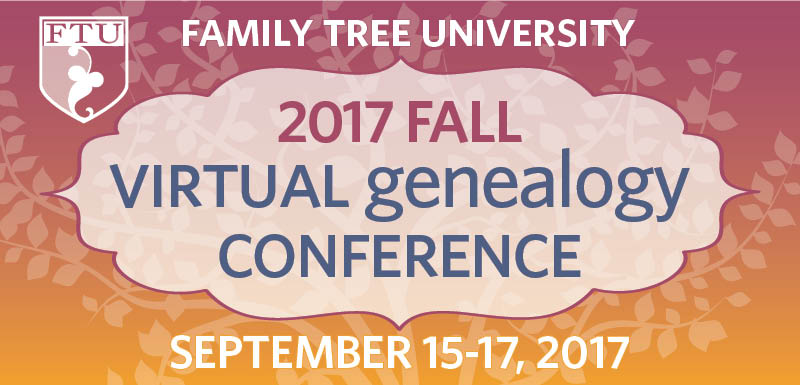
 I’m tying all these virtual classes together with a live keynote presentation, “Big Pictures in Little Details,” on Sunday, September 17, after which I’ll do a brief, live Q&A.
I’m tying all these virtual classes together with a live keynote presentation, “Big Pictures in Little Details,” on Sunday, September 17, after which I’ll do a brief, live Q&A.
The best part about the FTU virtual conference weekend: Not only can you participate from the comfort of your own home, but you won’t have to choose between presentations occurring at the same time. They’re all available to stream and download. So you can keep them and refer back long after the conference is over. Even my live keynote and Q&As will be recorded, so you won’t have to miss a thing!
Come join me for a fun-filled three days at the 2017 Fall Virtual Conference!





 If you have Anabaptist heritage, you may be aware of additional Anabaptist genealogy records that we have not mentioned. We would be delighted if you would share that information with our Genealogy Gems community in the comments below. We look to you to be an inspiration and teacher to us here at
If you have Anabaptist heritage, you may be aware of additional Anabaptist genealogy records that we have not mentioned. We would be delighted if you would share that information with our Genealogy Gems community in the comments below. We look to you to be an inspiration and teacher to us here at  Relatives who have never had a desire to delve into genealogy often roll their eyes when an enthusiastic genealogist in the family shares a newly discovered census or other genealogical record. And who can blame either party? The genealogist is giddy having won a long fought battle to unearth another piece of the family tree puzzle, and the non-genealogist hasn’t a clue what difference it all makes.
Relatives who have never had a desire to delve into genealogy often roll their eyes when an enthusiastic genealogist in the family shares a newly discovered census or other genealogical record. And who can blame either party? The genealogist is giddy having won a long fought battle to unearth another piece of the family tree puzzle, and the non-genealogist hasn’t a clue what difference it all makes.






 I’m tying all these virtual classes together with a live keynote presentation, “Big Pictures in Little Details,” on
I’m tying all these virtual classes together with a live keynote presentation, “Big Pictures in Little Details,” on